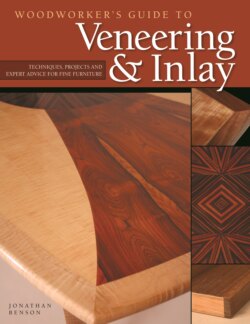Читать книгу Woodworker's Guide to Veneering & Inlay (SC) - Jonathan Benson - Страница 12
На сайте Литреса книга снята с продажи.
How wood grows
ОглавлениеWood grows by cell division: Cells divide outward to thicken and strengthen the tree’s branches and trunk, and new branch and twig cells also grow upward to allow the tree to compete for sunlight. The growing cells accept and transport moisture and nutrients, much like a sponge absorbs water. As new cells are added, the older cells die and strengthen. The outermost layer of cells just under the bark, where the actual cell division or growth occurs, is referred to as the cambium layer.
Figure 2-2. The way wood is sawn or sliced from the log determines the basic structure of its visible wood figure.
The dark-colored wood near the center of the trunk that ultimately supports the tree is known as the heartwood. Heartwood is most often used for woodworking. Sapwood, the layers of cells toward the outside of the trunk, transports sap, a mixture of moisture and nutrients, throughout the tree. Sapwood is often softer and lighter in color than heartwood, and is frequently discarded; however, particularly when matching veneers, the contrast in color between the heartwood and the sapwood can create a beautiful pattern to be used as a design element (Figure 2-1).
Wood cells are long, thin, and usually vertical. Individual cells cannot be seen by the naked eye, but long thin groups of cells known as fibers can be seen in most woods. The trunk grows outward during cell division, adding a new layer of wood each year. During the spring, a tree will grow relatively quickly, creating a layer of softer, lighter-colored wood. Then, in the summer and fall, growth slows, creating a denser, darker layer. The difference between the areas is seen as rings in the cross section of a tree (Figure 2-2), and cause what we see as the grain pattern in sawn boards. Different ways of sawing logs produce different grain patterns, as discussed on pages 20-21. Knowing how the cutting method affects grain pattern gives the craftsman a good idea of what to expect visually, a tremendous help in ordering and specifying wood and veneer.
Wood cells continue to absorb and give off moisture long after the tree has been sawn into boards or sliced into veneers. Summer’s high humidity causes the cells to swell, while low humidity and indoor heating during winter cause the cells to shrink. This expansion and contraction occurs across the width and thickness of the cells or grain but rarely along the length, and movement is much greater across the rings than in between them. Wood finishes can slow, but not stop, this seasonal movement of wood. Using quartersawn lumber (see here), however, can greatly reduce wood movement.
